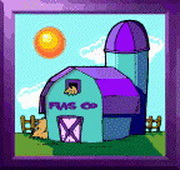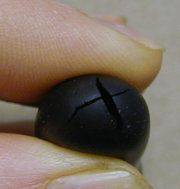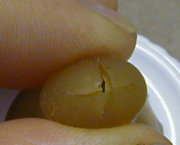Feeding Goats
Goats are ruminants; they have four stomachs. Their stomachs act like big fermentation vats. When you feed a goat, you are actually feeding the bacteria in this fermentation vat. The bacteria, in turn, make the nutrition in the food available to the goat's system. A goat's rumination method of processing food requires plenty of roughage and fiber to work properly. Although the goat's digestive system is similar to that of other ruminants, such as cattle and sheep, who are "grazers" and eat grass, goats are more related to deer, who are "browsers". As browsers, goats are designed to eat, and prefer, brush and trees more than grass. It is natural for them to nibble a little here, and nibble a little there. Though goats will eat grass, if you are considering getting goats to be lawnmowers, you are going to be sorely disappointed, because they will eat your trees and roses before they will work on the lawn. They really like bark and will strip the bark off trees. (especially pines, cedars and maples, to name a few). Goats could be used to help reclaim grasslands that have been overgrown with brush. Our land was overrun with brambles, wild roses, honeysuckle and 100s of small pine tree when we moved here; these are all gone now.
Never make big changes in the way you feed a goat all at once, or feed large quantities of a new food that the goat has never had before, if you do this, you can throw off the bacteria in the goat's rumen, which can cause the goat to bloat, or the rumen to shut down. When changing a goat's diet, do so slowly, to give the bacteria in the rumen time to adjust.
- What to feed goats: Types of food and food additives
- Edible & Poisonous Plant List
- How I feed my goats: My feeding method
- How
much to feed goats
- Colostrum: What is it and why do baby goats need it?
- Bottle feeding
- How can you tell if your goat is too fat?
My feeding method
This is the way I feed my dairy goats here, at Fias Co Farm. I have 20 adult does and three bucks (does and bucks are always housed separately)
We breed in the fall to kid in the spring. Our spring kids are always big, strong and healthy enough to breed in the fall (when they are at least 80 pounds, usually in 7-8 months).
Milkers are fed in the milk stand when they are milked.
All the other feeding is done at "tie stanchions". My goats ARE NEVER tied except at feeding time, and this is only under strict supervision. Because I have a separate "feeding station" for each goat, I know exactly what each goat is eating (or not eating). In this manner, is is also quite easy to administer their Weekly Herbal Worm Formula or any other supplement each individual needs. I can easily know that each goat is getting the correct amount of food, wormer, supplement, etc. If I were to "mass feed" their would be no way of knowing who was getting what, the stronger would always get more than the weak, thus, the weak will not receive the food and supplements they need. Yes, it is less convenient to feed individually, but it is well worth the extra work.
I train the goats to stand at their own station. Each goat goes to the same place everyday. They each get "clipped" on a short lead and then are served their own "bowl" with the proper food. When they are done they wait patiently until everyone is done and then they are let go. No mob scene at feeding time, it's great. I currently feed 21 goats at a time this way. It doesn't take as much space as you would think and takes no time at all to do.
When the goats are busy eating, this gives me time to clean out the barn without getting "help".
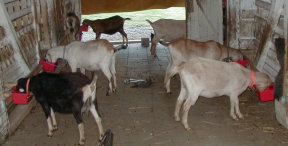 |
Some of my goats having a very orderly breakfast |
Waiting patiently after breakfast, while the "slow eaters" finish up. |
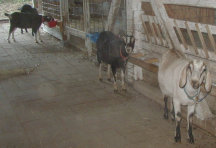 |
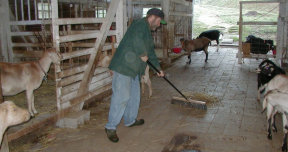 |
The goats have learned to wait as we sweep out the barn each morning. |
Kitchen & Garden Scraps: Goats as composters?
Yes! I used to collect my kitchen scraps to add to my compost pile, but they always started to smell and get moldy before I'd remember to take them down to the garden. One day I looked at my compost collection and realized that most of it would make good additions to our goats diet. These were all the vegetable & fruit cuttings: onion ends, banana peels, tomato ends, broccoli peelings, orange peels, garlic skins, etc. The only thing in the collection that the goats couldn't get was the egg shells. I now sort out the egg shells and give these back to the chicken to eat and feed the kitchen scraps to the goats. They love it and it is a good nutritional supplement to their diets. Because I give the scraps each day, there is never that much and so there is no worry about disrupting their stomach flora.
I do not usually give my goats food treats (they just like petting and attention as their treat), but if you wish to give your goats treats, a good choice is a few raisins or corn chips. Only give a few each time (feed one at a time) because you don't want to upset your goat's digestive system. You can feed a slice or two of bread as a treat, but never feed bread as a main part of your goat's diet.
I have heard outrageous things people feed to goats. Just because a goat will eat something does not mean you should feed it to them.
Paper: Goats like to browse and eat trees and bark, because of this, paper is naturally something they are interested in (it is made out of wood). But, paper has no nutritional value and it also contains a lot of things that aren't really good to consume. Do not feed your goat paper of any sort.
Cigarettes: Do not feed your goat cigarettes or cigarette butts (no matter out an "old timer" told you). Some people say you can use cigarettes to worm your goat, but if you want to worm your goat with a "natural" product, there are a lot safer natural wormers available.
Dog Food: Heck, I won't even feed my dog commercial dog food <smile>. Do not feed your goat dog food. A dog's dietary requirements (they are omnivores) are totally different than a goat's (who are herbivores) and dog food can disrupt the goats digestive system.
Cat Food: For goodness sake, do not feed your goat cat food! Cats are carnivores with a single stomach; goats are herbivores and ruminants with four stomachs. Carnivores and herbivores have two totally different dietary requirements.
Another Note on Dog & Cat food: Be aware that is illegal to feed any ruminate protein back to a ruminate as part of the scrapie/BSE control program. Most dog and cat food has ruminate protein in it, and is not labeled for goats, sheep, or cattle. This ban has been in effect since 1997.
Also See: Edible & Poisonous Plant List
Copper: Goats need copper; sheep should not have copper. Due to this, do not feed your goats feed or minerals intended for sheep. If you do, you may experience copper deficiency health related issue with your goats. This may not show up for years, but can be a serious problem.
What
I feed: see bottom
of this page info on |
|
Kids- from
birth to- |
Note: All the kids we raise on our farm are raised and nursed by their own mothers. I do not practice CAE prevention because removing a kid from it's mother at birth conflicts with my beliefs (see cae).
Sometimes something may happen and you may need to bottle feed. For a bottle feeding schedule, see below. |
Kids- 2
weeks to- |
|
Kids- does, bucks & wethers 2
months to- |
|
Wethers- over one year old |
|
Does- bred |
Tip for bred does: 2 months before kidding we supplement our does diet with Pregnancy Tonic Herb Mix |
Does- dry and not bred |
|
Does- in milk If you want milk, you must feed your goat accordingly. |
Be aware that with dairy goats, their milk production is about 9 to 10 per cent of their body weight, whereas a dairy cow produces 5 to 6 per cent of their body weight daily as milk. To maintain this level of milk production a dairy goat needs to eat between 5 to 7 per cent of her body weight daily; a dairy cow eats up to 4 per cent of her body weight per day. Be award that many times, no matter how much you feed, the doe will get thin. Does will put everything they have into milk production. It takes more out of a doe to make milk than to make babies!
|
|
|
Bottle Feeding Though I do not usually bottle feed our kids, sometimes it is necessary ... For instance: sometimes a doe will refuse a kid. Who knows why, she just does. Maybe they didn't bond well at birth. Maybe she just decides she only wants one kid. Maybe the kid is weak and nature tells the doe "survival of the fittest; don't bother with the weak kid". For whatever reason, if a doe does not except a kid within 24 hours, it is highly unlikely that she will ever accept him. In this case, the kid must be bottle fed. So you must always be prepared to bottle feed.
|
Babies
need to have Colostrum within an hour of birth. After they receive colostrum, bottle fed kids should be fed fresh (or frozen) goat's milk (not canned). If you do not have access to fresh goat's milk, you can use fresh raw cow milk (you can add 3 Tbs. of corn syrup per gallon of milk cow if you wish). If you do not have access to a fresh source of milk, use regular whole cow milk from the grocery store (again, you can add 3 Tbs. of corn syrup per gallon of cow milk if you wish). Don't use canned milk (goat or cow) and DO NOT FEED POWDERED MILK REPLACER/FORMULA. Real whole milk, even from a cow, is much better for them than milk replacer , which can cause diarrhea and floppy kid syndrome. Very often, problems with bottle fed kids stem from the use of milk replacer. The hole in most nipples is too small and will need to be made bigger. I used to use the larger type of "lamb nipple" and make the hole bigger by cutting an X in the top with scissors. I now like to use regular human baby bottles and nipples. I like these because they let the air into the bottle much better than the lamb nipples while the kid is drinking, making it easier to drink from. No matter what type of nipple you use, you must cut an "X" in the end of the nipple. Make the X bigger than you think it needs to be. See examples in the photos to the left. If the baby does not want to nurse, you must work with them. Sometime is it extremely (and I mean extremely) hard to get a kid to take a bottle. Be patient. Get him in your lap, pry open his mouth and shove in the nipple. He may struggle and not want the nipple. Milk will probably get everywhere but into the kid. Have paper towels on hand. Put yourself in his place. He has no idea what the bottle is and what you are doing. He wants his "real" mommy. Keep working with him. Speak calmly to him, and I find sometimes making sucking sounds, to help him understand what you are trying to get him to do helps (sometimes). Eventually hunger will aid you and he will realize the bottle is food, not some horrible torture device. It is especially hard to get a kid to take a bottle if they have nursed from a real teat. It has taken me up to 4 days to get kids to take a bottle (meanwhile, two people would have to hold the mother, who had refused the kid, so that he could nurse). Keep working with the kid. Make sure the milk is warm (103*), make sure the nipple is soft and warm. Kids don't like hard cold nipples: they aren't like "mommy". Keep the nipple in your warm pocket until right before you try the bottle. A kid's system is designed to drink from a nipple that is higher than his head so that milk goes down the "right way", bypassing the rumen which is not functioning yet. When you hold the bottle, you need to hold it up, at an angle so his head is pointing slightly up and his neck is slightly extended as he drinks. Here is the schedule
that I use.
Tip for weak, small or sick bottle babies: When a bottle baby needs a little extra boost I use the following special formula: 3/4 whole milk, 1/4 Ensure Plus and Immune Support Tincture. NOTES FOR BOTTLE FED KIDS: I let all kids, even bottle fed ones, live with the herd from day one; I never bring them in the house to live. The only kids brought in the house are kids that are so weak they must be tube fed. If a mother rejects one kid and I have to bottle feed him, he still is left to live with his sibling and mother. If the kid is orphaned, he is put with kids his own age. Bottle fed kids will bond and grow up with their like aged herd mates. They learn avoid the bigger goats and also to browse and be goats from the herd. Kids learn from their mothers, other adults in the herd and from older kids. Bottle fed kids who are not raised with the herd will not learn to eat grain, hay or browse as quickly as herd raised kids. They will not learn to drink water as quickly either. Since they have no older goats to learn from, and they get a bottle whenever they are hungry, they will not want to try new things to eat. If you get pizza all the time, why try broccoli? Bottle fed kids will not really start trying new foods unless you cut back on the bottle and offer these new foods. Do not bottle feed water; it is counter productive. This does not teach kids to drink water. If you fill their belly up with water from a bottle, they have no reason to try nibbling on new foods or drinking water out of a bucket. |
What is Colostrum and why does a baby goat need it?
Colostrum is the name for the first milk a mother (any mammalian mother) produces right when she delivers her baby. This special milk is low in fat, and high in carbohydrates, protein, nutrients and antibodies that help keep the new baby healthy All babies needs these antibodies because when they are first born, they have no antibodies in their systems yet and this leaves them open to any disease, illness or even death caused by viruses and bacteria. Colostrum actually works as a natural and 100% safe vaccine. The best colostrum is from the baby's mother because this contains "custom" antibodies for the particular environment the baby is born into.
A baby goat slowly looses the ability to absorb antibodies from colostrum and after 24 hours can no longer absorb antibodies at all, this is why you need to make sure they get their colostrum ASAP after birth.
The best Colostrum is from the kid's mother. It is always a good idea to milk out a little Colostrum from a doe that has recently kidded and freeze it in an ice cube tray and store the cubes in ziplock bags in the freezer for emergency purposes, such as a doe kidding with no milk or a doe dieing in childbirth. The Colostrum will stay viable for a year in the freezer.
It you do not have any real goat Colostrum, it is a good idea to have a real colostrum replacement on hand that contains viable antibodies. Be prepared ahead of time.
Important: A baby goat that does not receive any sort of colostrum within the first 24 hours of birth has much less chance of survival because their Immune Systems will be very weak as they start out in life.
Hay
I feed a good quality grass based hay without mold. I ask for "weedy" hay (which horse people would never feed their horses) because, not only is it cheaper, the weeds contain more nutrition (because weed roots grow deeper and reach more nutrients than grass roots do). The weedy hay is not crappy hay though. It shouldn't be old or moldy; it still should be harvested properly and not have been rained on after cutting.
Once a week we feed alfalfa hay (if I have it); the goats loves love it.
Note: No matter how great your hay is, the goat will waste hay, that is their nature. They will always pick though whatever you give them to find the best parts.
A note on hay feeders:
I use metal hay feeders/racks designed for horses/cattle and also special racks designed for goats. I modify the horse/cattle feeders to make the openings between slats a bit smaller to help not waste quite as much hay (goats will always waste hay; it seems to be a fact of life).
I have been asked about keyhole feeders for goats to help not waste hay. Keyhole feeders are very dangerous. Yes, they "hold" the goat's head into the feeder, and maybe help save some hay, BUT it also hold the goat's head in and she can't see and/or get away fast when she is about to be rammed by another goat. I have known goats to get injured badly due to keyhole feeders. I have never had them here. I know other breeders who installed keyhole feeders and later removed the keyhole part after goats got hurt. It is next to impossible to provide the prefect hay feeder so that goats do not waste hay. That is just the way they eat.
Question: Can I use Alfalfa cubes (that look like tiny hay bales) as a total replacement for hay?
Answer: You can feed these in conjunction with hay, but not as a total replacement. Goats need the long fiber in hay for their rumens to work properly. The cubes are too chopped up and processed to be a total replacement. Also, you need to be aware that your goats will not be able to eat those hard cubes "as is". You need to either break them up with a hammer or soak them in warm water.
My Pasture
Goats are "browsers" (like deer) and "grazers" (like cattle & sheep) and will always prefer browse as opposed to grass if given the opportunity. Goats are not lawnmowers, and if you are thinking of getting goats so that they will mow your lawn, you will be sorely disappointed. But, they will happily kill many of your trees and shrubs for you.
My pasture is diverse. My steep land contains a variety of browse, i.e. pine trees, saplings, brambles, honeysuckle, poison ivy, herbs and weeds of many sort. The "flats" of my land contains a variety of grasses, clovers, herbs and weeds.
When I do have areas that need a bit of seeding, here is the mix I have formulated that I use:
Goat Pasture Seed Mix
Some people have asked me the rate at which this is applied. This recipe was developed by ratio of the seeds to each other, not by any set amount to use per area of land. All land is different. To be honest, I really do not know the rate for this mix per acre. Also your land is different than my land, so what works for me may not be right for you. I apply this mix, throwing it out by hand, where ever I need some seeding. I've done entire fields this way.
Note: This is not a premixed blend and is not purchased from any particular company. It's just a mix I developed based on the needs of goats and seeds that are available. Your local feed store should have most of these seeds, and you can always substitute where needed (it's not rocket science).
.
*I have read that fescue can be poisonous to goats (due to endophytic fungus in the grass, which produces several types of alkaloids that are toxic to animals) but I have never seen any problems in my goats when fed fescue in moderation. My goats graze "fresh" fescue and also eat fescue hay. If you do not want to use fescue, substitute rye grass.
Grain
You can find various feeds formulated for especially for goats, or you can adapt what you can find in your area, and at your locate feed store.
If you can't find a good feed especially for goats, you can feed a good 12%-16% course grain for horses or cattle "sweet feed"; just look at the tag labels and find something comparable. Often horse feed is made with better ingredients than sheep, goat or cow feed. Use the analyses below to help find a grain for your use.
I no longer feed feed for "Sheep & Goats" because this contains no copper and goats need copper, whereas sheep can't have it. I am concerned that the lack of copper in these sheep & goat mixes may leave the goats with a copper deficiency.
I feed a 16% Textured premix "Pro-Line 16% Mare & Foal " that is actually for horses. I have found our goats like a "granola" type grain the best. This contains whole grains as well as pellets mixed with molasses. Interestingly, my goats do not particularly care for Purina Goat Chow.
The
following is the analysis of some grain exceptable for goats that you can use for comparison purposes: |
||||
16% Textured Sheep & Goat Feed NOTE- this has no copper so should not be use for goats. All other % numbers are good. |
Pro-Line 16% Mare & Foal (from Producer Feeds) This is what we feed. |
Purina Goat Chow |
||
| Crude protein | minimum | 16% |
16% | 16% |
| Crude fat | minimum | 3% | 4% | 2.5% |
| Crude fiber | maximum | 8% | 6.5% | 9% |
| Calcium | minimum | 0.80% | 0.50% | 0.80% |
| Calcium | maximum | 1.30% | 0.90% | 1.30% |
| Salt | minimum | 0.5% | ||
| Salt | maximum | 1% | ||
| Copper | minimum | 30 PPM | 39 PPM | |
| Copper | maximum | 42 PPM | ||
| Phosphorus | minimum | 0.60% | 0.40% | 0.60% |
| Selenium | minimum | 0.60 PPM | 0.30 PPM | 0.60 PPM |
| Vit A | minimum IU/LB | 4500 | 5,000 | 4000 |
| Vit D | minimum IU/LB | 1,000 | ||
| Vit E | minimum IU/LB | 25 | ||
| Zinc | minimum | 100 PPM | ||
